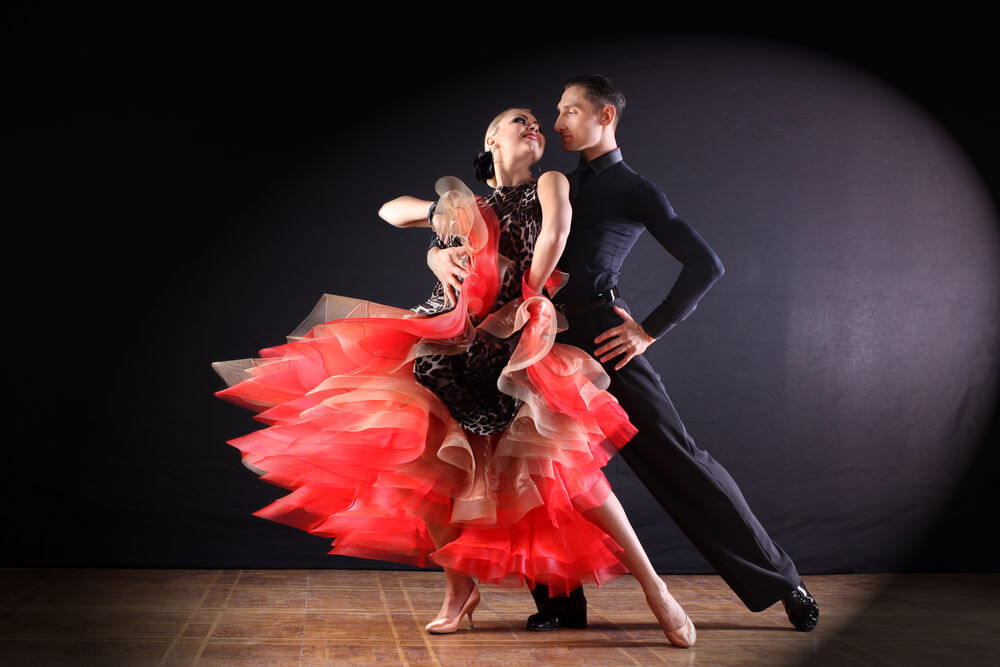We all know that dance is an awe-inspiring art form, but did you realize dance had an effect on other forms of art as early as 3500–3300 B.C.? It’s true. There is evidence that Ancient Egyptians often painted representations of dancers on pottery and, later on, tombs too. It’s a little bit of a brain teaser, but our kinetic art can be portrayed quite beautifully in visual art, and today we’re taking the time to appreciate many of the gorgeous works completed throughout time.

It’s one thing to be on the dance floor, nailing the Samba. But can you imagine if someone were to recreate your precise movements in sculpture or painting form? Talk about the ultimate flattery! As if you needed another excuse to take dance lessons! Take a step back in time with us on a mini-tour of our favorite representations of dance in art. Maybe one day, you’ll be a muse.
Favorite Representations of Dance in Art
Edgar Degas’ “Ballet Rehearsal” – 1873
French Impressionist painter Degas had a flair for painting dancers and capturing their movements in his works. “Ballet Rehearsal” is one of his most popular pieces, but his full page of works listed here is comprised of romantic dance representations, mostly ballet. View the painting here.
Why we love it: Accuracy and poise. Degas easily portrays the beautiful movements ballet dancers are so famously known for. The work is realistic and inspiring at the same time.
Susan Cutts’ “Who Knows Where the Time Goes” – 2012
Made from paper, this stunning but haunting sculpture of a ballerina (if you can call it that) is able to harness childhood dance memories while eliciting the notion that dance can never leave you, no matter how old you are. See the sculpture here.
Why we love it: Curiosity. Cutts’ sculpture lets your mind wander and is able to bring about strong feelings because of the delicate medium used.
Titian’s “Bacchus and Ariadne” – 1520-23
Showing a different type of dance movement, rather to tell a story, this painting by popular 16-century Venice artist Titian shows Bacchus, the god of wine, and his followers on the right. The work captures the moment he falls in love with Ariadne (left) at first sight, leaping gracefully to her chariot. View the painting here.
Why we love it: The emotion. To dance, you must feel, and the raw emotion in this painting tells a story resulting in dance-like movements, much like real-life.
Trisha Brown’s “Proscenium Works 1979-2011” – 2014
Bringing dance-inspired art to a whole new medium, modern choreographer Brown uses her performance as the work, creating dance paintings with her body. This way, dance is portrayed in both the inception and the result—too cool, right? See the works here.
Why we love it: Innovation. Just like dances never stop evolving, we love Brown’s out-of-the-box take on artwork. Plus, it’s just fun to watch!
Leonor Fini’s “Le Palais du Cristal” – 1952
Known for her strong portrayal of women in her works, Fini’s watercolor is both pretty and strong—a great way to show off girl power. She especially ensures to use fluent lines to showcase the beautifully muscular bodies of dancers. View the painting here.
Why we love it: Girl power. This piece makes a statement with the single subject centered, further suggesting that dancers, while they may execute gracefully, are very strong.
Jack Vettriano’s “The Singing Butler” – 1992
Scottish artist Vettriano’s oil-on-canvas work, portraying an umbrella-ed butler and maid singing to a couple dancing in the rain, became a contemporary cultural icon. The painting has been criticized for the lighting, wind, and dancers’ positions, yet it sold for a record-breaking £744,800 in 2004. See the painting here.
Why we love it: The spontaneity. Dance is used to express many emotions, one of these being love. We can’t help but feel transported to this romantic beach setting, watching two well-dressed lovers dance in the rain.
“Dancing Girl” – 2500 B.C.
A prehistoric bronze sculpture discovered in modern-day Pakistan shows a teenage girl with her hand on her hip. It was perhaps best described by British archaeologist Mortimer Wheeler in 1973: “She’s about fifteen years old I should think, not more, but she stands there with bangles all the way up her arm and nothing else on. A girl perfectly, for the moment, perfectly confident of herself and the world. There’s nothing like her, I think, in the world.” See the sculpture here.
Why we love it: History. Seeing dance (and female confidence) conveyed such a long time ago is a feat to be noted. It spurs much curiosity about culture and the people during bygone eras.
Pablo Picasso’s “The Three Dancers” – 1925
What’s an art article without Picasso? The well-known abstract artist used triangular positioning to show a dance of love, sex, and death in this energetic oil painting. Reflecting Picasso’s personal memories of the heart-broken suicide of friend Carlos Casagemas, this work still leaves much to be explored. View the work here.
Why we love it: Honesty and form. The jagged edges outlining the three dancers make for an interesting view, but we also love how much emotion is conveyed, even though it may not be positive.
There’s no doubt that even from the beginning of time, dance was a huge part of society! Pick up where history left off and sign up for your first free dance lesson today—this is the sign you’ve been looking for.
{{cta(‘a7d6e4e1-a911-4f2b-8b43-6210da6d93fb’)}}
Leave a Reply